There are eight types of bears: the polar bear, brown bear, American black bear, spectacled bear, Asian black bear, sloth bear, sun bear, and giant panda.
Together, the eight bear species make up the living members of the bear family Ursidae.
Ursidae is part of a larger group of mammals, the order Carnivora, which is also home to the cat family (Felidae), the dog family (Canidae), and several other families of primarily carnivorous (meat-eating) animals.
Bears are known for their omnivorous diet, although some types of bear (e.g. the polar bear) are highly carnivorous, while others (e.g. the giant panda) are almost entirely herbivorous.
Other characteristics shared by all types of bears include: an excellent sense of smell; five strong, nonretractable claws on each paw (unlike a cat, a bear can’t retract its claws back into the paw for protection); powerful bodies, and plantigrade locomotion (i.e. a bear walks on the soles of its feet, unlike animals such as cats and dogs, which walk on their toes). Most bears hibernate for at least part of the winter.
On this page are pictures and facts on all of the different types of bears. Scroll down to see them all, or use the index below to go to a particular species.
Types Of Bears
- American Black Bear (Ursus americanus)
- Asian Black Bear (Ursus thibetanus)
- Brown Bear (Ursus arctos)
- Giant Panda (Ailuropoda melanoleuca)
- Polar Bear (Ursus maritimus)
- Sloth Bear (Melursus ursinus)
- Spectacled Bear (Tremarctos ornatus)
- Sun Bear (Helarctos malayanus)
(American) Black Bear
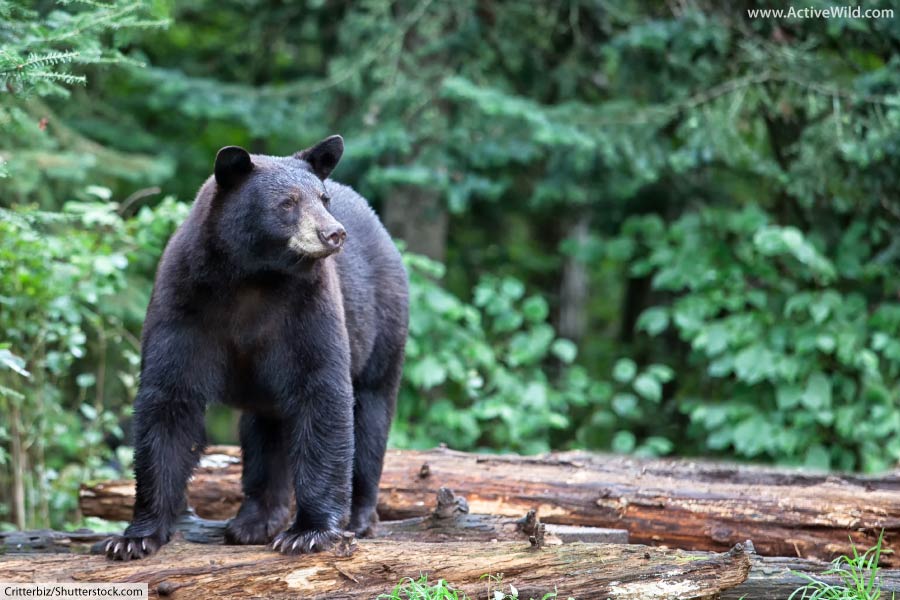
- Other Names: Black bear
- Scientific Name: Ursus americanus
- Conservation Status: Least Concern
- Where Found: North America
- Max. Weight: (Male) 530 lb / 240 kg; (Female) 318 lb / 144 kg
American Black Bear Facts
- The number of American black bears alive today is thought to be twice that of all other bear species combined.
- The American black bear is more closely related to the Asian black bear than it is to the other American bear species.
- Some American black bear subspecies are actually reddish-brown or even blonde in color!
Although the American black bear is the smallest of the three bear species found in North America (the other two being the brown bear and the polar bear), on average it is the world’s third-largest species of bear.
In North America, the American black bear is known simply as the “black bear”. As the name suggests, its coat is usually black, but in some regions the “black” bear can be brown, cinnamon-colored, or even blonde.
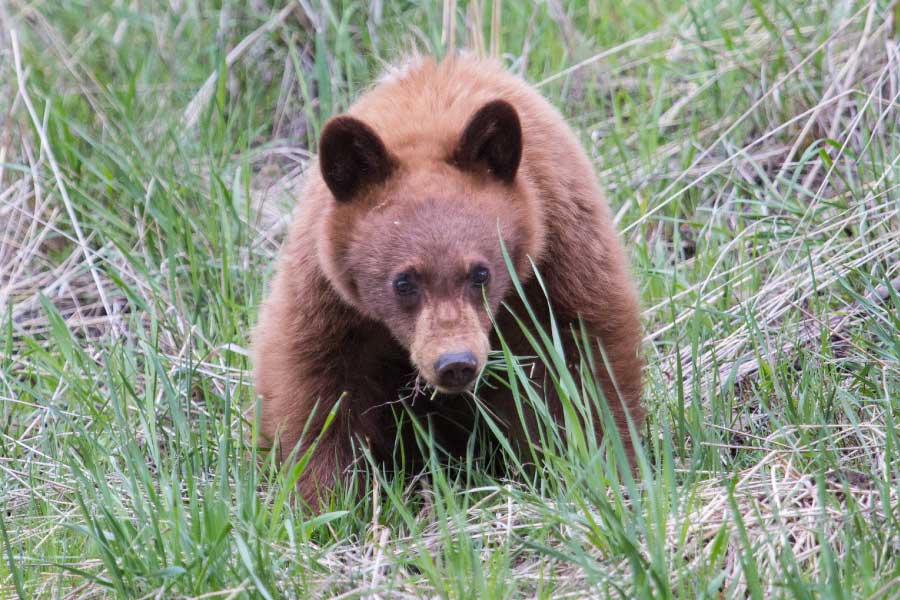
- The cinnamon bear (Ursus americanus cinnamomum) is a black bear subspecies found in the central United States, including Colorado, Wyoming, Utah, Idaho and Montana. It has a reddish-brown, “cinnamon” colored coat.
- The Kermode bear (Ursus americanus kermodei), a black bear subspecies found in British Columbia, Canada, is occasionally born with a blonde coat. Individuals with this coloration are known as “spirit bears”. Around 10% of Kermode bears have this creamy-white coloration; the others are of the standard, black variety.
The American black bear is present in the majority of US and Canadian states, and its population and range, unlike those of many other large animals, are both increasing.
The bear is usually found in forests, but in some parts of its range is also found in swamps, scrublands and tundra.
A skilled climber, the American black bear has an arboreal (tree-dwelling) lifestyle, particularly when young. Its claws are shorter and sharper than those of the brown bear – an adaptation for climbing trees. As they grow older, black bears become more terrestrial (ground dwelling).
In the northernmost parts of its range, the black bear hibernates for up to 7 months of the year. Conversely, in the southernmost regions of the species’ range, the bears may not hibernate at all.
Typically for a bear, the black bear is an omnivore. However, plants make up the majority (up to 85%) of its diet.
Carrion forms an important part of the black bear’s diet when it emerges from hibernation. At other times, insects form the bulk of the animal part of the bear’s diet, but the species will also prey on mammals and fish.
You can find out more about the American black bear on this page: American Black Bear Facts
Discover more amazing American animals on this page: North American Animals List with Pictures & Facts
Asian Black Bear
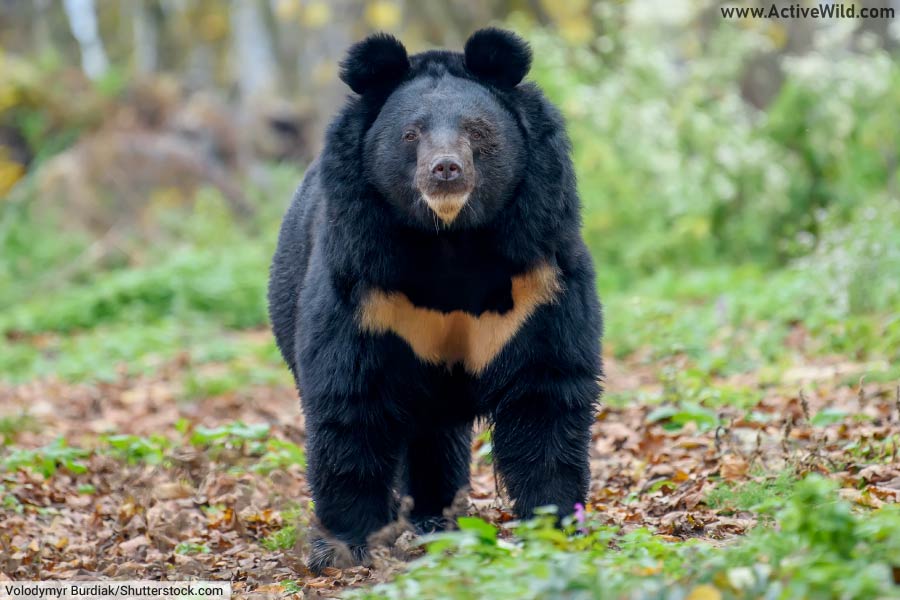
- Other names: Asiatic black bear, moon bear, white-chested bear
- Scientific Name: Ursus thibetanus
- Conservation Status: Vulnerable
- Where Found: Asia
- Max. Weight: (Male) 440 lb / 200 kg; (Female) 276 lb / 125 kg
Asian Black Bear Facts
- The Asian black bear is closely related to the American black bear.
- The species spends as much as 50% of its life in trees.
- The Asian black bear spends more time walking on its hind legs than any other type of bear.
The Asian black bear is found in forests across much of southern Asia, its range stretching from Iran in the west to Japan in the east.
The Asian black bear is closely related to the American black bear, and the two species are similar in both size and overall appearance. Unlike its American cousin, however, the Asian black bear has a prominent white patch, which is often V-shaped, on its chest.

The sun bear and sloth bear also have a pale marking on their chests. One theory suggests that this mark may act as a warning signal to potential predators – in particular, to tigers. All three of the “pale-chested” bears evolved alongside tigers; the chest marking might tell a tiger that the bear is aware of its presence and prepared to fight if necessary.
The Asian black bear is an opportunistic omnivore, altering its diet depending on what is available at the time. It is primarily herbivorous, although not as much as the American black bear and the almost entirely herbivorous giant panda.
Fruits and nuts make up the bulk of the Asiatic black bear’s diet. The bear also eats other plant matter such as shoots and leaves. The animal part of the bear’s diet includes insects, deer, boars and cattle. As well as hunting its own prey, the Asiatic black bear will eat carrion and scavenge the prey of other predators.
Bears that live in the north of the species’ range hibernate during the winter, whereas bears found further south are active all year round.
You can find out more about this species here: Asian Black Bear Facts
Discover more amazing Asian animals on this page: Asian Animals List with Pictures & Facts
Brown Bear
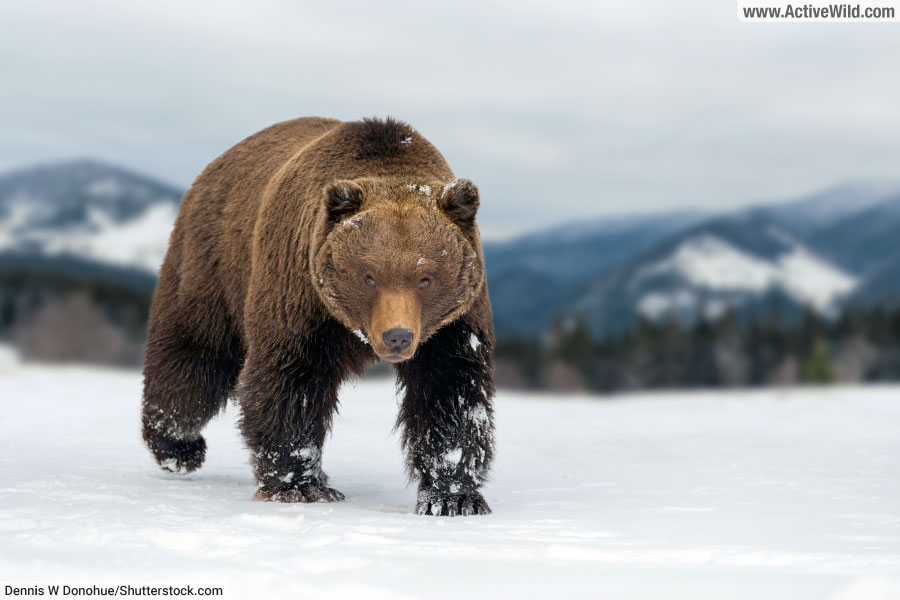
- Scientific Name: Ursus arctos
- Conservation Status: Least Concern
- Where Found: North America, Asia, Europe
- Max. Weight: (Male) 1,400 lb / 635 kg; (Female) 701 lb / 318 kg (Kodiak bear subspecies)
Brown Bear Facts
- The range of the brown bear is larger than that of any other bear. The species is found in North America, Europe and Asia.
- The brown bear is closely related to the polar bear.
- Brown bear subspecies include the grizzly bear, Kodiak bear, Eurasian brown bear and Himalayan brown bear
The brown bear is, on average, the second-largest species of bear; only the polar bear is larger. The brown bear’s color ranges from very dark brown (almost black) to pale, reddish brown. The grizzly bear, a brown bear subspecies found in North America, is named for the “grizzled”, pale appearance of the tips of its hair.
The brown bear is built for digging, rather than for climbing. The “hump” of muscle above its front shoulders provide its forelimbs with incredible power, and its long (up to 2.4 in. / 6.1 cm) claws are strong enough to break through tough earth.

Brown bears vary considerably in size; the largest subspecies of brown bear, the Kodiak bear, is similar in size to a polar bear, whereas a small female Himalayan bear might be only slightly larger than a large sun bear (the smallest type of bear).
The Kodiak bear, a brown bear subspecies found on the islands of Alaska’s Kodiak Archipelago, is almost as large as (or even larger than) the polar bear.
The largest brown bears are those found in areas with a plentiful supply of spawning salmon. The usually solitary bears often congregate in good fishing spots, gorging on the fish during the spawning season.
One of the best-known brown bear subspecies is the fearsome grizzly bear, which is found in the United States and Canada. Although most human / bear encounters pass without incident, “grizzlies” can be aggressive, and walkers are advised to carry bear spray for protection when in bear country.
The brown bear is a true omnivore, feeding on the widest range of food of any bear. Depending on where it is found, a brown bear may eat shellfish, insect larvae, rodents, and even large hoofed animals such as moose and boar. Plant matter such as fruit, nuts and grass, as well as bulbs and roots that the bear excavates with its powerful claws, are equally important.
You can find out more about the brown bear on this page: Brown Bear Facts
Giant Panda
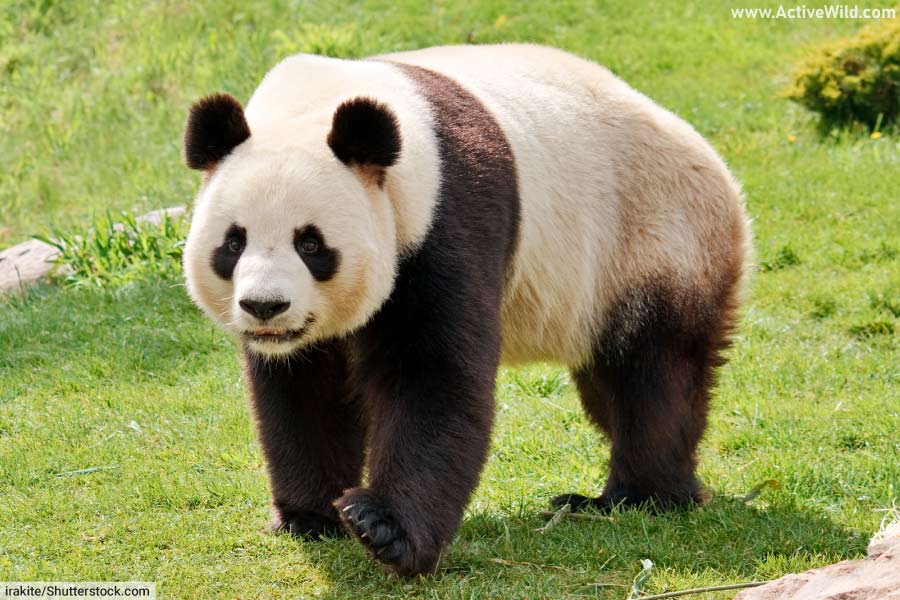
- Scientific Name: Ailuropoda melanoleuca
- Conservation Status: Vulnerable
- Where Found: China
- Max. Weight: (Male) 350 lb / 160 kg; (Female) 275 lb / 125 kg
Giant Panda Facts
- The giant panda is also commonly known as the panda. The “giant” part of its name helps differentiate between it and the red panda (another bamboo-eating Asian species, which, despite its name, is not a bear).
- The panda has the second-longest tail of all bears. (Only the tail of the sloth bear is longer.)
- Despite being classed as a carnivoran, the panda is almost entirely herbivorous
- The panda poops up to 40 times per day!
With its black and white body and black eye-patches, the giant panda is one of the world’s most recognizable animals. This distinctive bear is featured in the logo of the WWF and is the figurehead of many other conservation organisations.
Although the giant panda is still threatened, it is no longer an endangered species. Its wild population now comprises over 1,800 individuals and is thought to be increasing.
Although out of immediate danger, the giant panda is still rare and highly vulnerable due to its dependence on the bamboo forests in which it lives.
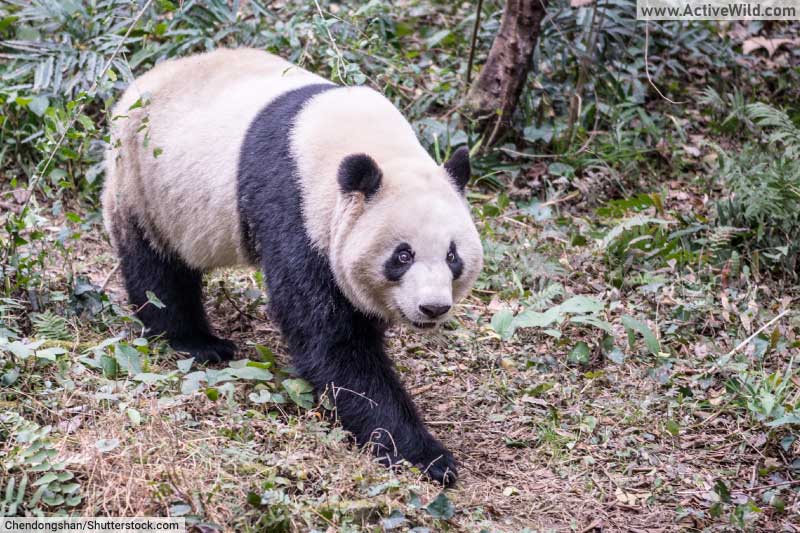
The panda is the most herbivorous of all bears, feeding almost entirely on bamboo stems. The species has even evolved a “sixth digit” – in reality a thumb-like projection of bone – to help it hold bamboo stems while eating.
Unfortunately for the panda, its digestive system still resembles that of its more carnivorous forebears, which means that it is able to extract very little nutrition from bamboo. This simply means that the panda has to eat vast quantities of bamboo – up to 30 lb / 14 kg – per day in order to survive. A giant panda may spend up to 15 hours a day eating!
The giant panda is endemic to (only found in) China, where it inhabits bamboo forests in the Sichuan, Shaanxi and Gansu provinces. Most of the world’s pandas are found in the Minshan, Qinling and Qionglai mountain ranges.
You can find out more about the giant panda on this page: Panda Facts
Discover more amazing Asian animals on this page: Asian Animals List with Pictures & Facts
Polar Bear

- Scientific Name: Ursus maritimus
- Conservation Status: Vulnerable
- Where Found: within the Arctic Circle in North America and Europe
- Max. Weight: (Male) 1,543 lb / 700 kg; (Female) 772 lb / 350 kg
Polar Bear Facts
- The polar bear is, on average, the largest of all bears.
- The polar bear is found further north than any other species of bear.
- The polar bear is the most carnivorous bear species, eating very little in the way of plant material.
With its great size and white coat, the polar bear is one of the world’s most recognizable animals. Weighing up to 1,540 lb / 700 kg, the polar bear is not only the largest species of bear, it is also the world’s largest land carnivore.
The polar bear is closely related to the brown bear, and is believed to have evolved from the brown bear, gaining numerous adaptations for living in the cold, inhospitable north.
The polar bear is found in Arctic regions of numerous countries, including Canada, the United States (Alaska), Greenland, Norway and Russia.
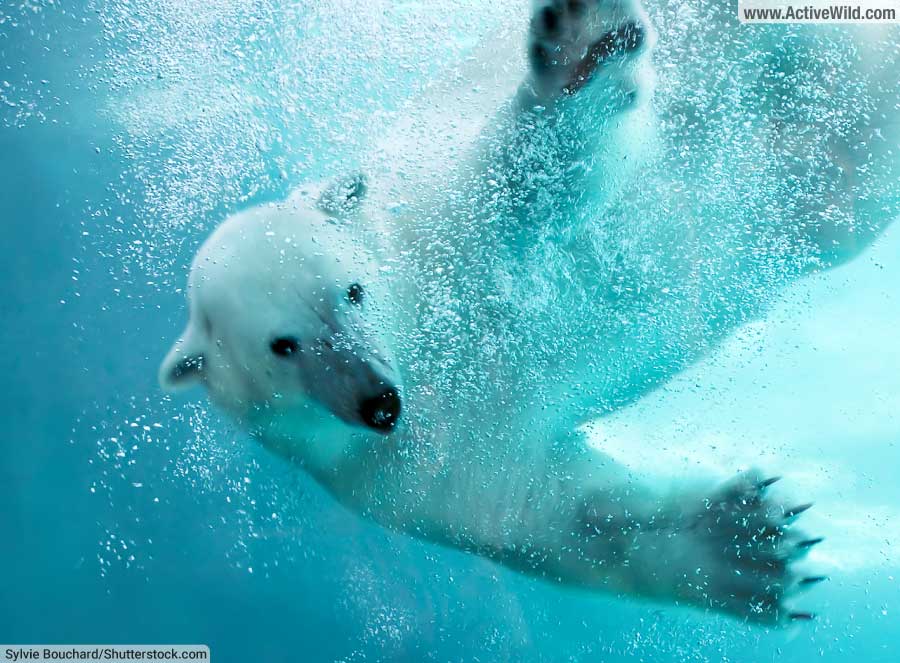
During the winter, the polar bear inhabits the Arctic sea ice, spending so much time at sea that it is considered to be a marine mammal. When the sea ice contracts during the summer, the bear becomes more terrestrial (land-dwelling).
Seals form the bulk of the polar bear’s diet, with the ringed seal and bearded seal being particularly important prey animals.
You can find out more about the polar bear on this page: Polar Bear Facts
Discover more amazing Arctic animals on this page: Arctic Animals List with Pictures & Facts
Sloth Bear
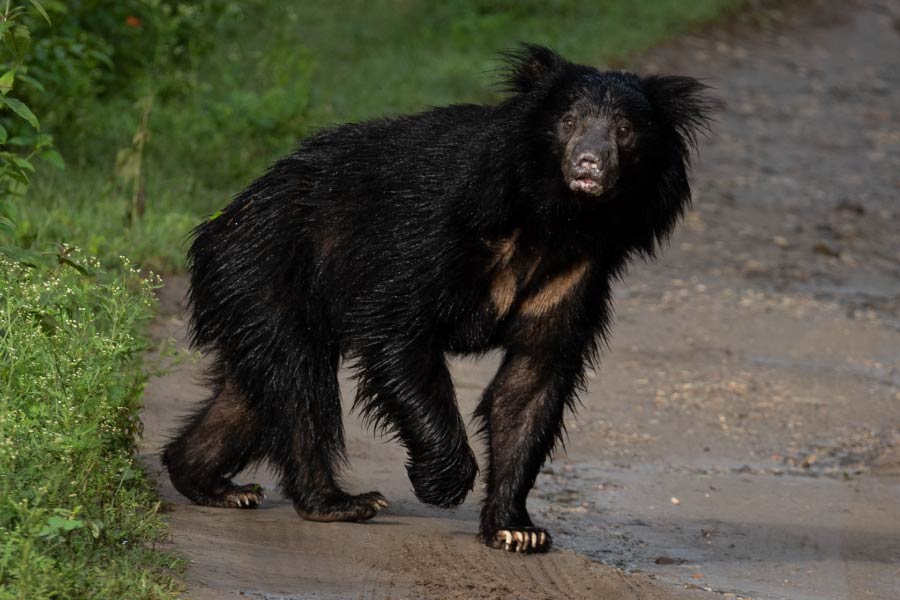
- Scientific Name: Melursus ursinus
- Conservation Status: Vulnerable
- Where Found: Asia (Indian Subcontinent)
- Max. Weight: (Male) 320 lb / 145 kg; (Female) 231 lb / 105 kg
Sloth Bear Facts
- The sloth bear is an insectivore (insect-eater)
- The sloth bear can be highly aggressive, and is considered one of the most dangerous bears
- The sloth bear has the longest tail of all bears.
The sloth bear is a medium-sized bear, slightly smaller than the American black bear and Asian black bears. Its long, shaggy fur is either black or dark brown in color.
On the sloth bear’s chest is a cream-colored, roughly V-shaped marking. The mark is variable in size and shape and is not present on all individuals.
The extremely large paws of the sloth bear are equipped with long, curved, white-colored claws. As with all bears, the claws are “non-retractable” (i.e. they cannot be pulled back into the paw like those of a cat).
The claws of the sloth bear are designed for breaking into termite mounds. The sloth bear is primarily insectivorous, feeding mainly on ants and termites (a behavior known as “myrmecophagy”). When available, fruit is also an important part of the bear’s diet.
Despite its seemingly harmless dietary preferences, the sloth bear can be extremely dangerous if encountered in the wild. It reacts to potential predators – be they tigers or humans – with aggression. This behavior may be a result of the sloth bear’s claws being too long for efficient climbing; with escape into the trees not being an option, the bear’s best defensive option may be to attack a perceived aggressor.
The sloth bear is found in India, Nepal and Sri Lanka, with 90% of the species’ population being found in India. The species inhabits a wide range of habitats, including tropical forests, scrublands and grasslands.
You can find out more about the sloth bear on this page: Sloth Bear Facts
Discover more amazing Asian animals on this page: Asian Animals List with Pictures & Facts
Spectacled Bear
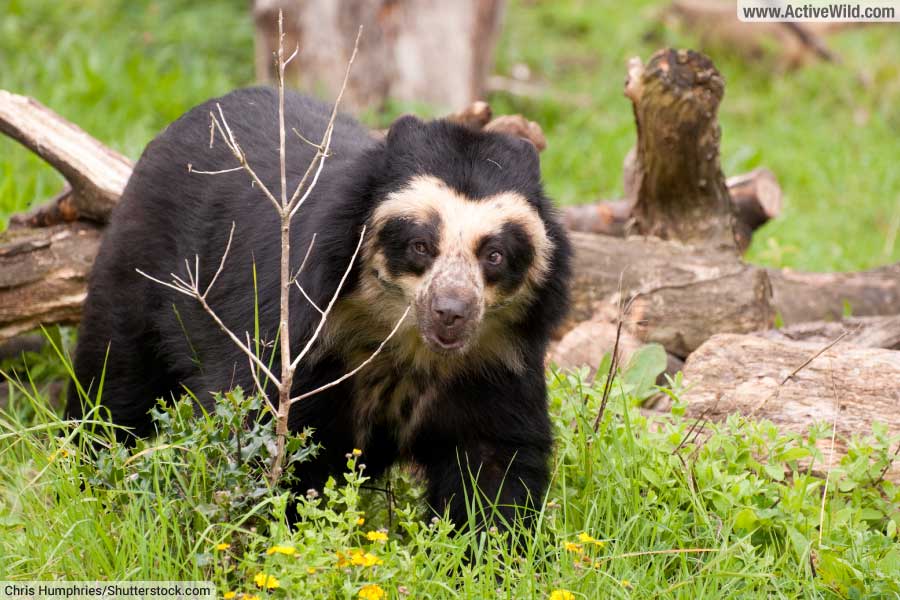
- Scientific Name: Tremarctos ornatus
- Conservation Status: Vulnerable
- Where Found: The Andes, South America
- Max. Weight: (Male) 440 lb / 200 kg; (Female) 180 lb / 82 kg
Spectacled Bear Facts
- The spectacled bear is found further south than any other species of bear.
- The fictional Paddington Bear was a spectacled bear!
The spectacled bear is the only bear species found in South America, and the only living member of the bear subfamily Tremarctinae (the short-faced bears), which includes fearsome prehistoric species such as the giant short-faced bear, considered one of the largest land carnivorans ever to have lived.
The spectacled bear lives in the Andes mountain range and is present in Venezuela to Bolivia.
The species is named for the spectacle-like appearance of its facial markings, which form a cross around the bear’s eyes, although not all individuals have these pale orange markings.
The bear’s body is black / dark-brown in color, with a white or orange-white chest and throat patch. A large male spectacled bear can weigh up to 440 lb / 200 kg, and the species the largest land Carnivoran (member of the mammalian order Carnivora) found in South America.
The spectacled bear is primarily herbivorous, with meat making up only around 6 percent of its diet. It the most herbivorous bear species after the giant panda. Plants eaten by the spectacled bear include cacti, bromeliads and various fruits.
Occasionally, the spectacled bear may prey on mammals such as rabbits, tapirs, rodents and birds. It will also feed on carrion.
You can find out more about the spectacled bear on this page: Spectacled Bear Facts
Discover more amazing mountain animals on this page: Mountain Animals List with Pictures & Facts
Sun Bear
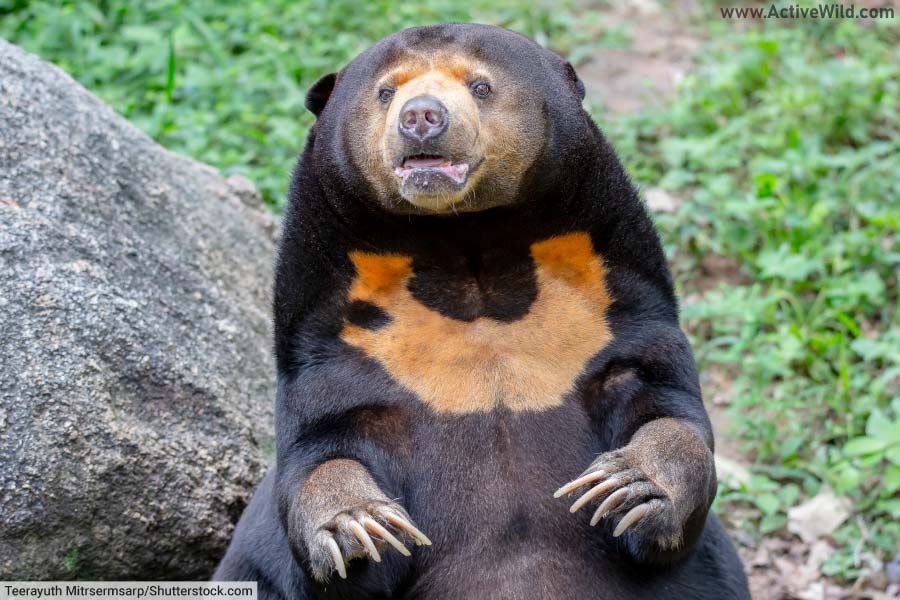
- Scientific Name: Helarctos malayanus
- Conservation Status: Vulnerable
- Where Found: Southeast Asia
- Max. Weight: (Male) 145 lb / 65 kg; (Female) 125 lb / 57 kg
Sun Bear Facts
- The sun bear is the world’s smallest bear.
- The species is the most arboreal bear, spending a higher percentage of its life in the trees than any other type of bear.
The sun bear is the world’s smallest bear species, with a maximum shoulder height of around 28 in / 70cm, and weighing up to 145 lb / 65 kg. It is usually black in color, although dark brown or reddish individuals are known.
The sun bear has a distinctive white / orange-white, U-shaped chest patch. This resembles a setting sun, and gives the species its English name.
The sun bear is found in Southeast Asia, both on the mainland, in countries such as India, Thailand, Myanmar, and Malaysia, and also on islands such as Borneo and Sumatra.
The most arboreal (tree-dwelling) of all bears, the sun bear is found in several types of tropical forests, including rainforests.
The sun bear has a typically omnivorous diet, eating insects such as ants, termites and the larvae of beetles and bees and beetles, honey and fruit. (The sun bear is also known as the honey bear due to its love of honey.)
Long, powerful claws enable the sun bear to dig into the ground or break up wood in order to find food. Its tongue – the longest of any bear – helps it to gather food such as honey and grubs from trees.
You can find out more about the sun bear on this page: Sun Bear Facts
Discover more amazing Asian animals on this page: Asian Animals List with Pictures & Facts
More Bear Information On Active Wild
You can find out more about bears on this page: Bears – The Ultimate Guide
Discover more about the different types of mammal on this page: Types of Mammals


